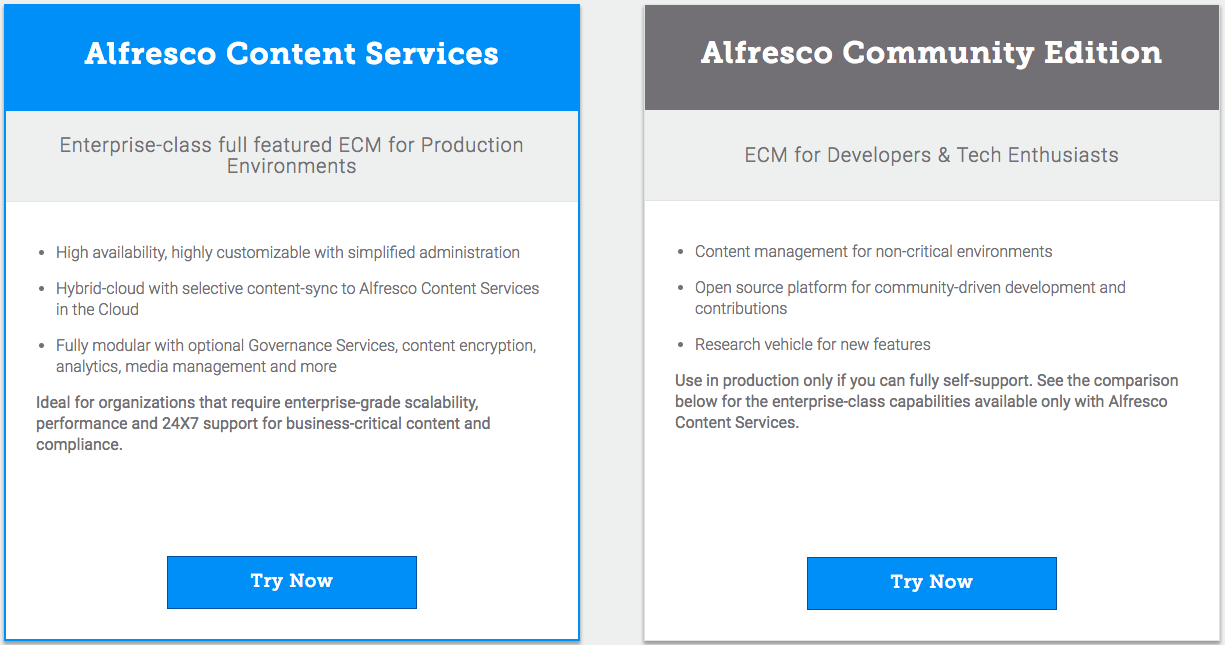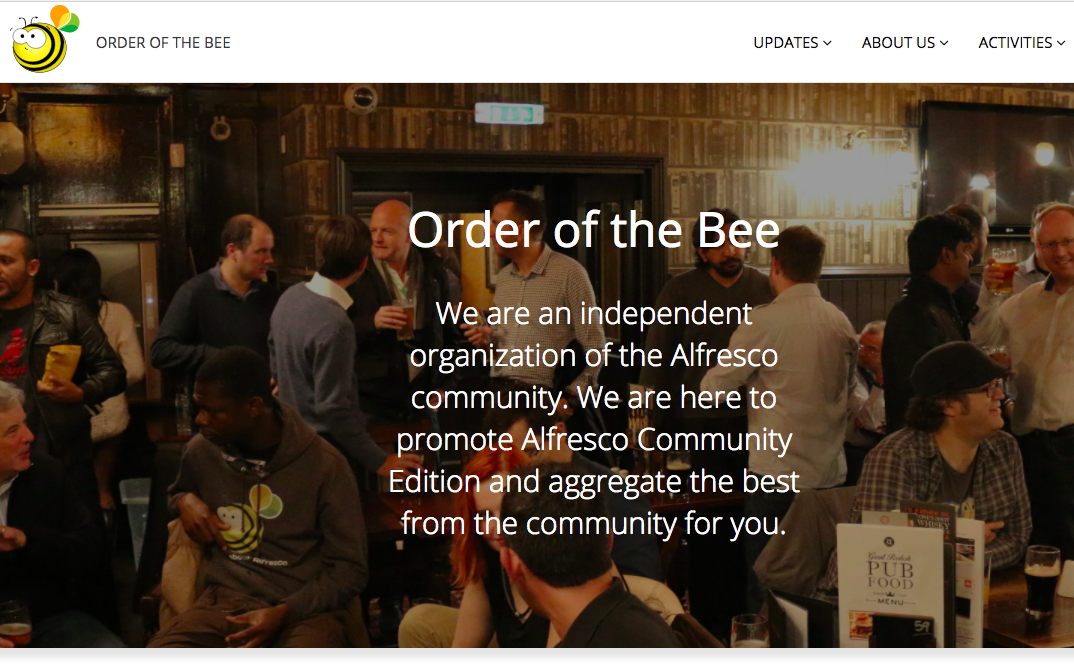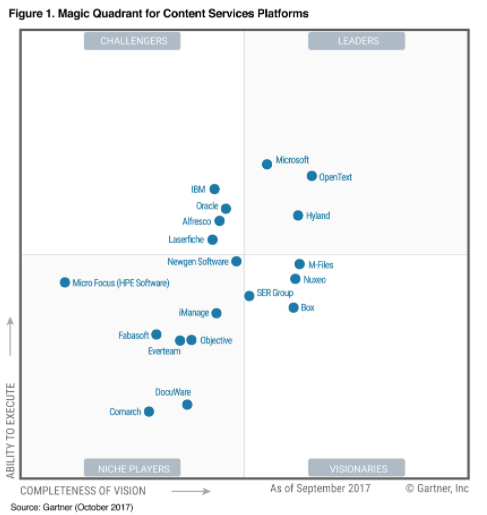Soluzioni Legali, approcci business ed Organizzativi adottate dai competitor
Competitor e noti player
- Alfresco
- Docker
- Kubernates
- Liferay
- Nuxeo
- OpenStack
- Sonatype
- WaveMaker
Licenza Alfresco (storia)
"When we looked at open source companies, and we were particularly impressed by JBoss, and they used LGPL. So when we first started we used the LGPL license, and those days Alfresco was unknown. And lot of people said to us the LGPL wasn’t so a good license. Because the LGPL for big companies, they think is like the GPL, they don’t understand, it was confusing at that level. And a lot of other companies could take the LGPL, not contributing anything back, so we were advised to change to the MPL license, because it was like the LGPL, in terms of the effect of the MPL license, but it operates at file level, so technically you could explain MPL, while no one really knows how technically, legally how the LGPL works. So we changed to MPL and that was quite successful, but we then were basically running into the problem that the MPL doesn’t work well on the Web.
Basically we work with Matt Asay, he said why we try all these ‘exotic licenses’ like LGPL, MPL, which, particularly in US, the legal guys ask lots of questions.. let’s just say GPL, GPL is not perfect, but virtually all common open source projects use GPL, so it is a sort of ‘standard’, so that is why we changed." (John Newton)
https://robertogaloppini.net/2009/05/16/open-source-ecm-alfresco-business-strategy/
Strategia Open Alfresco
Consider that:
- “Drive Open Innovation” not “Open Source” is a core value to the company as publicly expressed on the Our Values page.
- The leadership team has no open source experience (except John Newton and PHH whose open source experience is Alfresco and Activiti).
- The community team doesn’t exist any more–the company has shifted to a “developer engagement” strategy rather than having a dedicated community leadership or advocacy team.
When John and Paul also hoped that the open and transparent nature of open source would lend itself to developer adoption, third-party integrations and add-ons, and a partner ecosystem, which it did. (Jeff Potts)
https://ecmarchitect.com/archives/2015/05/24/4017
Alfresco Community vs Commerciale

Alfresco Go-to Market
- Disrupt the ECM market
- Create ancillary services
- Differentiate on scalability
Ecosistema Alfresco

http://orderofthebee.org/
Companies that sell open source are prioritizing community and adoption over instant monetization
(Jonathan Schwartz, Sun Microsystems)
Docker/Kubernates/OpenStack
- Licenziati con Apache fin dal concepimento.
- La "promiscuità" come mezzo per la diffusione.
- Docker: $276M di investimenti; Subscriptions
- Kubernates: attendance cresciuta del 400% '16-'17
OpenStack
But Openstack is somewhat unique as an open source project. It was 2010. Amazon had enormous early mover momentum in providing cloud services [2006]. Eucalyptus was open source-licensed but controlled by a single vendor (née 2009). Cloudstack was just published under an open source license [May 2010] but still closely held by Cloud.com. The time was ripe for a vendor neutral option. (Stephen R. Walli)

https://opensource.com/business/15/3/why-openstack-different-other-open-source-projects
OpenStack
There are 9 projects (Linux, KDE, Apache, Eclipse, Perl+CPAN, Mozilla+Addons, Gnome, Drupal and GNU) that stand out as significantly larger - roughly 10 times - than any others. All of these projects, categorized as "XtraLarge", are developed as collaborative community projects governed by non-profit foundations. No single vendor project has so far been even close to reaching their magnitude. There appears to be a glass ceiling limiting the growth of the Large single-vendor projects (MySQL, Qt, OpenOffice, Mono, JBoss). (Henrik Ingo)
http://openlife.cc/blogs/2010/november/how-grow-your-open-source-project-10x-and-revenues-5x?page=1
OpenStack

http://openlife.cc/blogs/2012/july/cloudstack-has-proof-foundations-way-create-foss-community
Liferay
As early as 2002, people wanted to supplement Liferay’s portal core with web content management and collaboration capabilities. Forum software packages like Ultimate Bulletin Board were very popular back then, but most were written in PHP, so Liferay added message boards and became a good Java alternative.
In those years the common thread was that it was mostly developers, working on projects for their organizations, who defined requirements and worked with Brian to build them. But over time, we had customers lend their voices to the mix as well, which took the product in new directions because their requirements reflected deeper business needs or the specific demands of enterprise IT. For example, Goodwill Industries, a major non-profit organization in the US with nearly $3 billion in assets under their management, had specialized requirements around how to represent their organizational hierarchy and generate sites for the groups in it. This is how Liferay’s Organizations and Communities were born. Another major customer wanted a better interface for managing multiple portal sites running in production, which led to the development of our Control Panel.
Storia di Liferay
https://sourceforge.net/blog/open-source-business-liferay/
Of course, we believe open source is its own reward and that community participation is about maximizing what we at Liferay call “Return on Giving”—when we give away our software for free, that gift returns back to us in the form of improvements, bug fixes and everything else our community gives in return. Likewise for our customers: when they sponsor a feature to be developed and release the IP back to Liferay, they will get much more on top of that once the community takes that feature and runs with it. It will end up being more rich and robust than if they had kept it behind their corporate firewall.
Well, that’s all fine and good, but at the end of the day, free software doesn’t feed your family. So we wanted to give our community members an opportunity to monetize their investment in the Liferay platform. At first, back around 2005, we simply created a plug-in repository for people to contribute their stuff. But we got more ambitious after seeing what Apple managed to do. So we decided to release the Liferay Marketplace, which allows our community to upload everything from simple themes and plug-ins to full-blown enterprise apps (BPM portals, learning management systems, ERPs), under the open source or proprietary license of their choice and either as free or for purchase.
Strategia Open Source Liferay
Strategia di prodotto Liferay
We had two offerings. One was a developer support option, which was priced ridiculously cheap at something like $16,000 for six months for unlimited questions—80% of which ended up not even being about Liferay but rather about CSS or ESBs or some other ancillary technology. That was very popular. The other was Production Support, which allowed customers to call or email us if they ran into issues running Liferay in production. Now there were two problems with that offering. The first was that people figured they would just purchase Support when they needed it—when a problem came up. Understandable, but didn’t make a good business model for us. The second—and this was more important, because it meant we weren’t providing the right value to the customer—was that our support offering didn’t meet enterprise needs. Here’s what I mean. Back then there was always one continuously evolving branch of Liferay, and new features, bug fixes, performance updates all got mixed up in the same branch. So when people had bugs or issues, the answer was always the same—upgrade to the latest version. If you were on 3.6.1 and experienced a problem with single-sign on, and Liferay had fixed it in 4.0, you had to switch to 4.0. Our support folks would tell you that, and they might even point you to the JIRA ticket that mentioned it and show you how to build a patch, but the recommended path was to upgrade. Being a small, nimble organization, we didn’t realize at first that that wouldn’t sit well with enterprise customers. Over time, the light bulb went off and we introduced the Enterprise Edition of Liferay, which basically provided what we never had before: long-term maintenance updates of Liferay that would not add new features (and therefore instability)—only bug fixes, performance enhancements, and security fixes. Not only that, we would pro-actively create new Service Packs for our customers, and we would have a library of Fix Packs for known isolated issues that customers could apply to production instances of Liferay. This was a much more enterprise-friendly approach to software and the results have been phenomenal for us.
Take Aways
- 1. At some point you need a product manager able to integrate customers’ needs into product’s features.
- 2. The importance of moving to a plug-in architecture, enabling third-parties to add features
- 3. Long maintenance matters in the enterprise market
- 4. Both Product and Customer development are key to your success
- 5. Channel partners and marketplaces are a must unless you want to build a lifestyle company.
https://robertogaloppini.net/2013/01/17/company-led-projects-liferay/
Nuxeo
Nuxeo Licensing
- Apache License
- https://doc.nuxeo.com/nxdoc/licenses/
- A volte LGPL:
http://fermigier.com/blog/2008/07/first-release-nuxeo-webengine/
Open Source di Nuxeo
- Nuxeo is open source. We offer subscription licensing for our services and tools. Our pricing varies based on customer support and system requirements and includes access to our configuration tool, Nuxeo Studio, the Nuxeo Marketplace and associated connectors to other systems, and different SLAs for technical support.
Nuxeo Product
- Nuxeo Enterprise Content Management (ECM) fornisce servizi di document management, case management, e digital asset management.
- Nuxeo Galaxy Partner Program consente ai Solution Providers di pacchettizzare le loro competenze per offrire soluzioni verticali chiamate Content-Enabled Vertical Applications (CEVAs);
- Nuxeo CMF è stato il primo case management framework rilasciato in open source.
Gartner Magic Quadrant

Licenza WaweMaker
- Inizialmente rilasciato come AGPL
- Successivamente passato ad Apache
http://www.keeneview.com/2010/02/it-takes-community.html
Sonatype (Nexus)
- Apache-oriented
- Crea un repository (Nexus) e lo rilascia con GPL
- Ragioni:
- a clear need to protect their investment and allow the company to profit from them;
- the will to share code and (if possible) code production;
- the will to not prevent private enhancements;
- be pragmatic avoiding any dogmatic approach.
Soluzioni Legali ed Organizzative adottate dai competitor
By rgaloppini
Soluzioni Legali ed Organizzative adottate dai competitor
- 812
